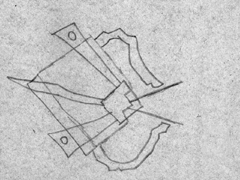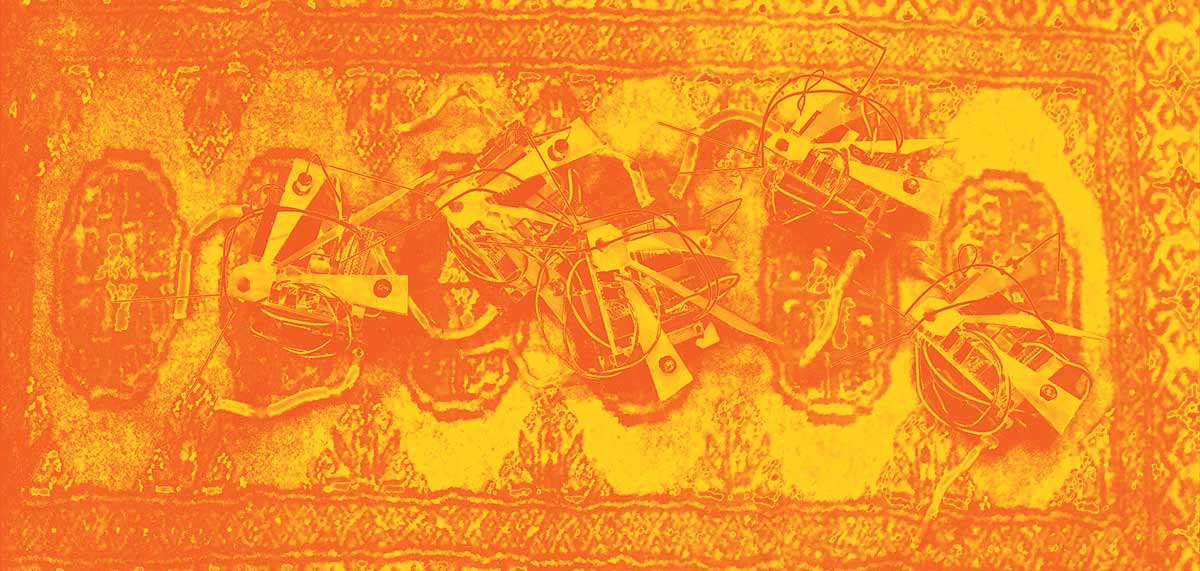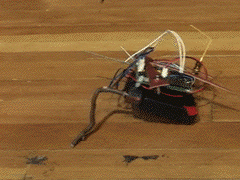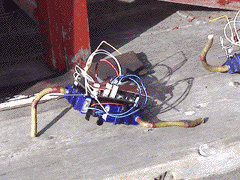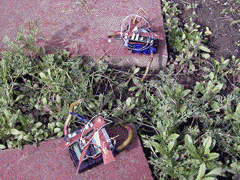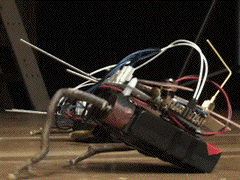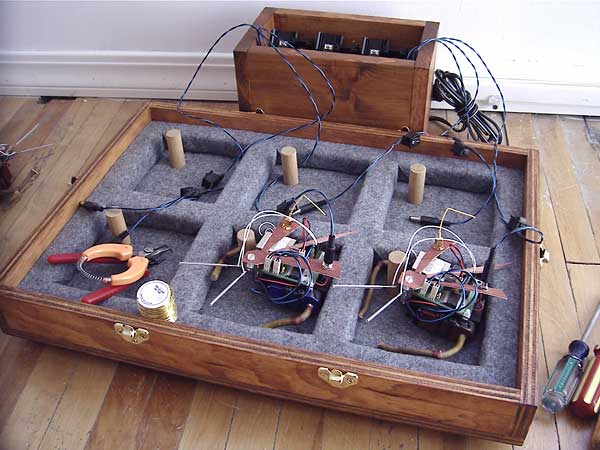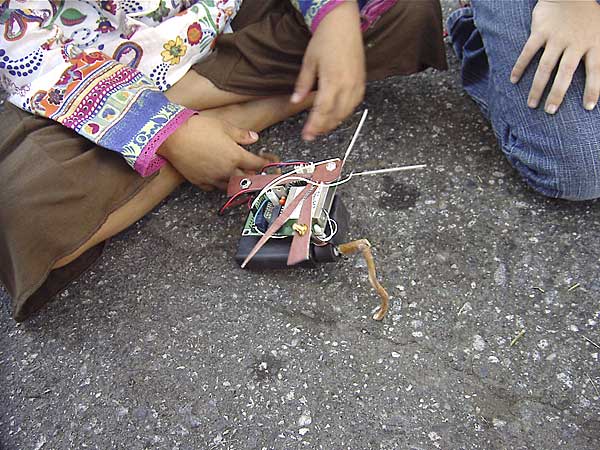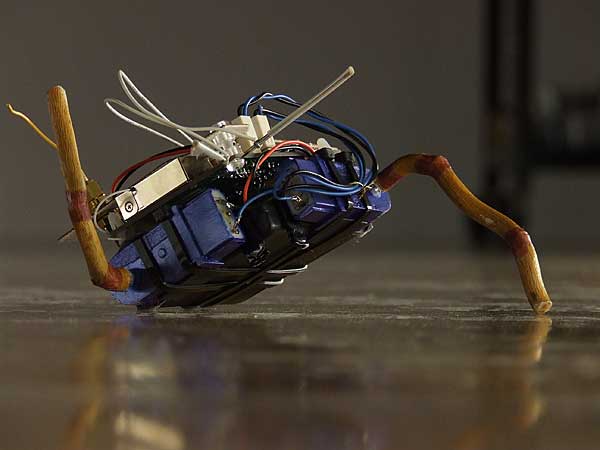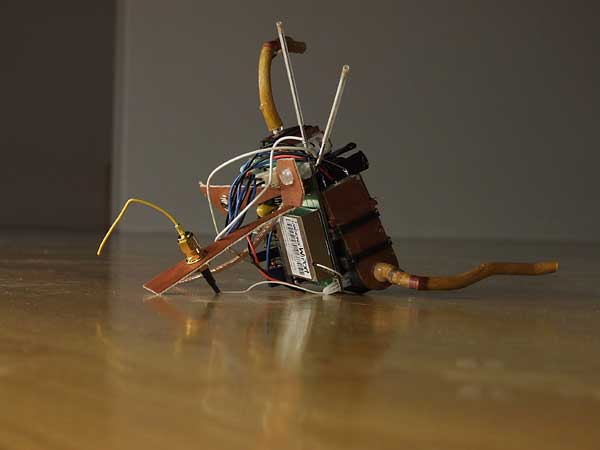
| ||

| ||
| < 2008 .. laughing | H O M E | magnetic .. 2006 > |
|
Preying Insect Robots
Visitors to this site can read the poetic broadcasts of the preying insect robots - ongoing montages based on found text from science fiction novels and short stories. New versions of the poetry are generated everytime the site is visited using a web version of the code that runs on the robots.
Original sketches of the prototype robots.
AUDIO CD You can listen to this album on Bandcamp
POETRY GENERATOR Each insect-bot works with a unique selection of found text to create poetic montages that are broadcast to the Internet. Awake or asleep, the robots stir through a list of extracted phrases and put forth ideas about creation and birth, ceasation and death. The text is drawn from a number of science fiction stories: Feersum Endjinn (1994) and Excession (1996) by Iain M. Banks; The Martian Chronicles (1946 - 1958) by Ray Bradbury; Autofac (1955), Do Androids Dream of Electric Sheep (1968), and The Electric Ant (1969) by Philip K. Dick; Mortal Engines (1972 - 1976) by Stanislaw Lem; and For a Breath I Tarry (1966) by Roger Zelazny. The poetry is generated everytime you reload the web-page.
MANIFESTATIONS
2. Insect Robots exhibition, web-site, and audio CD release at SOIL/Neutral Ground in Regina, July 2006. 3. Pavement Excursions in Vancouver, Late August 2006. 4. Exhibition "START" curated by Christof Migone, at the Galerie Leonard & Bina Ellen Art Gallery, Concordia University, Montréal, May 5 - June 9, 2007. 5. Outdoor exhibition with Second Site at VanDusen Botanical Gardens in Vancouver, July - September 2007. 6. Preying Mantis Robot Rockstars - 5.1 surround sound version presented at Shuteye Cinema, Eye Level Gallery, Halifax, October 18, 2008. 7. Preying Mantis Robots as specimens - shown in their wooden display case at The Material Glitch: Technoscience Gone Wild (a "pop up" exhibition at Quinary Art Projects in Vancouver, curated by Erik H Rzepka x-o-x-o-x-o.com) July 31, 2012.
The insects in their re-charging box. Neutral Ground/SOIL in Regina, July 2006.
Neutral Ground/SOIL in Regina, July 2006.
Outside at a block party in Vancouver, August 2006.
blueisi_ at START, Ellen Gallery in Montréal, May 2007.
When the dancing gets too exuberent at START, Ellen Gallery in Montréal, May 2007.
Hiding near the lakeshore at VanDusen Botanical Garden in Vancouver, July 2007.
REFERENCES
American science fiction author, Ray Bradbury, wrote "The Martian Chronicles" between 1946 and 1950, during the end of World War II and the beginning of the Cold War. The book is a series of short stories that chronicle the colonization of Mars by Americans and the eventual return of these colonists to an Earth that has been ravaged by atomic war. The chronicles portray the negative aspects of Western civilization - its destructive capacity, its unwillingness to learn from others and the schism that exists between technology, nature and philosophy within this society. The comparison is drawn between the balanced, telepathic culture of the Martians and the greed-based culture of America. There is one particular scene where an Hispanic American has an encounter with a ghost from the past (and at the same time, the Martian from the past meets a human ghost from the future). 4000 years of history separate the two ghosts. The Martian cannot believe that his world will not exist in the future. The human cannot believe that the world that his people destroyed was so rich and vibrant. This project is inspired by this encounter: a conversation through time, and the strange vehicle/mechanical-creature that the Martian uses to travel. "And out of the hills came a strange thing.
(From "August 2002: Night Meeting", The Martian Chronicles by Ray Bradbury. Published by Bantam, several editions since 1951.)
The insect-bots make acoustic (or mechanical) sounds and have an hybrid organic-mechanical nature. In the same way that Ray Bradbury talks about the green insect making a sound like raindrops, the preying-robots scurry, clank, whir, etc. in a way that suggests natural (or organic) living processes, while at the same time having an obvious mechanical nature. A group of these devices become animated (or orchestrated via their wireless connection / telepathic network) in a space in a performative way. Each robot has distinct "alone" modes of activity and group modes that are controlled by conversations on the wireless network. Individual robots engage in search patterns to find the others; they move in formation, engage in erratic actions, search for light and dark, fall asleep and wake. Over time the nature and level of their social interaction changes. As they wander, they transmit an erratic dialog of poetry to the Internet - working with found text from a number of works about the creation/birth of (artificial) intelligence. Each robot's physical structure is built around a battery pack. There are two motor driven arms cut from twisting willow branches. On top of this sits the "brain" and wireless hardware as well as the wings, feelers, and various wires and sensors. It is interesting to think of life-resembling objects "talking" to each other on the Internet without any human interaction or eavesdropping. In 2003, I curated and produced a collaborative network project entitled "Scrambled_Bites". One of the key premises of this project was the idea of a "data stream". The purpose of the "data stream" was to allow multiple devices around the world to contribute to a pool of sensor data that could then be sampled in various ways by devices listening to the stream. The system that the insect-bots use to communicate is similar.
The mantis-like vehicle of the Martian Chronicles is a ghost - something from the distant past of a culture both colonized and eradicated. The preying insect robot also positions itself as a ghost - a device that sits between the robots and refined mechanical devices of an industrial utopia (imagined in Europe in the late 1800s) and the electronic, networked utopia of the future (envisioned at the end of the 20th Century). The robots embody several concepts/places where people drift between fear and wonder: the insect, the robot, telepathy, computer "conversations" on the network that are unmediated by people, and notions of a man-made creature that has no specific industrial application.
One of the central ideas of Bradbury's Martian society is a seamless integration between technology and nature; intelligence and animal instinct; dream and reality (the Martians are telepathic). The Martians don't deal in binary dichotomies such as black and white, good and evil, zero and one, or biological and mechanical. Electro-mechanical processes can both mimic and integrate into life processes. The preying insect robot's usefulness or position in the "web of life" is suspect. It raises questions about industrial/technological philosophies and ethics. It is both self-determined (egocentric) and networked (social); self-propelled and unable to feed itself (dependent on someone else to charge its battery pack). It can talk to others of its kind on a "global" network that is wired directly into its brain. As it crawls along the sidewalk it is both closer to the earth and closer to the net than the person/people who built it.
|
|
absolutevalueofnoise.ca | audio available on bandcamp |
